cast iron products
The Versatility and Endurance of Cast Iron Products
Cast iron, a material that has been employed for centuries, continues to be a staple in various industries due to its durability, thermal conductivity, and versatility. From cookware to machinery components, cast iron products are renowned for their strength and resilience, making them a preferred choice for both industrial and domestic applications.
What is Cast Iron?
Cast iron is an iron alloy that contains 2% to 4% carbon, along with varying amounts of silicon, manganese, and other elements. This composition gives cast iron its unique properties, including excellent castability and machinability. The making of cast iron involves melting iron and alloying it with carbon and other materials, before pouring it into molds to solidify. This process enables artisans to create intricate designs and robust shapes, catering to a wide array of needs.
Applications in Cookware
One of the most popular applications of cast iron is in cookware. From skillets to Dutch ovens, cast iron cookware is celebrated for its heat retention and even cooking. Chefs and home cooks alike appreciate the way cast iron can go from stovetop to oven without missing a beat. Moreover, with the right care, cast iron cookware can last a lifetime, often being passed down through generations as treasured family heirlooms. The ability of cast iron to develop a natural non-stick surface through seasoning only adds to its appeal, promoting healthier cooking with less oil.
Industrial Uses
cast iron products

Beyond kitchens, cast iron plays a critical role in industries such as construction, automotive, and manufacturing. Cast iron pipes, for example, are known for their remarkable strength and resistance to corrosion, making them ideal for water transport and drainage systems. Similarly, in machinery, cast iron components like engine blocks and machine frames are favored for their ability to withstand high stress and heavy loads. The material's excellent vibration damping properties also contribute to smoother operation in various mechanical applications.
Sustainability of Cast Iron Products
In an age where sustainability is paramount, cast iron products stand out for their longevity and recyclability. While many materials have a limited lifespan and contribute to landfill waste, cast iron can be recycled indefinitely without loss of quality. This characteristic makes it an environmentally friendly choice, aligning well with modern sustainability goals. As industries seek to reduce their carbon footprint, the revival of cast iron in various applications not only emphasizes durability but also promotes responsible consumption and waste reduction.
Design and Aesthetic Value
Cast iron products are not only functional but can also be aesthetically pleasing. Many artisans create beautifully designed cast iron pieces that can serve as decorative items in homes and public spaces. From ornate candle holders to intricately designed garden furniture, cast iron's versatility allows for a range of artistic expressions. This melding of a robust material with artistic flair showcases the enduring appeal of cast iron in the realm of design.
Conclusion
In conclusion, cast iron products represent a fascinating blend of durability, versatility, and sustainability. Their applications span from kitchenware to industrial components, making them indispensable across various fields. As consumers and industries increasingly prioritize longevity and eco-friendliness, cast iron remains a timeless choice that is sure to endure in the modern age. Whether for cooking, industry, or art, cast iron continues to embody strength and innovation, proving that some materials only improve with age.
-
Wrought Iron Components: Timeless Elegance and Structural StrengthNewsJul.28,2025
-
Window Hardware Essentials: Rollers, Handles, and Locking SolutionsNewsJul.28,2025
-
Small Agricultural Processing Machines: Corn Threshers, Cassava Chippers, Grain Peelers & Chaff CuttersNewsJul.28,2025
-
Sliding Rollers: Smooth, Silent, and Built to LastNewsJul.28,2025
-
Cast Iron Stoves: Timeless Heating with Modern EfficiencyNewsJul.28,2025
-
Cast Iron Pipe and Fitting: Durable, Fire-Resistant Solutions for Plumbing and DrainageNewsJul.28,2025
-
 Wrought Iron Components: Timeless Elegance and Structural StrengthJul-28-2025Wrought Iron Components: Timeless Elegance and Structural Strength
Wrought Iron Components: Timeless Elegance and Structural StrengthJul-28-2025Wrought Iron Components: Timeless Elegance and Structural Strength -
 Window Hardware Essentials: Rollers, Handles, and Locking SolutionsJul-28-2025Window Hardware Essentials: Rollers, Handles, and Locking Solutions
Window Hardware Essentials: Rollers, Handles, and Locking SolutionsJul-28-2025Window Hardware Essentials: Rollers, Handles, and Locking Solutions -
 Small Agricultural Processing Machines: Corn Threshers, Cassava Chippers, Grain Peelers & Chaff CuttersJul-28-2025Small Agricultural Processing Machines: Corn Threshers, Cassava Chippers, Grain Peelers & Chaff Cutters
Small Agricultural Processing Machines: Corn Threshers, Cassava Chippers, Grain Peelers & Chaff CuttersJul-28-2025Small Agricultural Processing Machines: Corn Threshers, Cassava Chippers, Grain Peelers & Chaff Cutters












